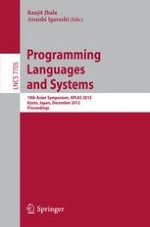2012 | Book
Programming Languages and Systems
10th Asian Symposium, APLAS 2012, Kyoto, Japan, December 11-13, 2012. Proceedings
Editors: Ranjit Jhala, Atsushi Igarashi
Publisher: Springer Berlin Heidelberg
Book Series : Lecture Notes in Computer Science
